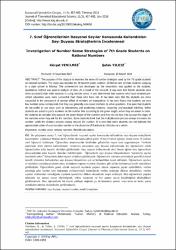7. Sınıf öğrencilerinin rasyonel sayılar konusunda kullandıkları sayı duyusu stratejilerinin incelenmesi
Abstract
Bu çalışmanın amacı 7. Sınıf öğrencilerinin rasyonel sayılar konusunda kullandıkları sayı duyusu stratejilerini incelemektir. Çalışmaya Manisa’da bir devlet okulunda eğitim gören 19 kız,19 erkek öğrenci olmak üzere 38 yedinci sınıf öğrencisi katılmıştır. Öğrencilere araştırmacılar tarafından geliştirilen başarı testi uygulanmıştır. Verilerin analizinde nitel yöntem kullanılmıştır. Araştırma sonucunda sayı duyusu kullanımında kız öğrencilerin erkek öğrencilerden daha başarılı oldukları görülmüştür. Sayı duyusu kullanımında okul öncesi eğitim alan öğrencilerin almayanlardan daha başarılı oldukları belirlenmiştir. Öğrencilerin işlemlerin sayılar üzerindeki etkisi sayı duyusu bileşeninde daha başarılı oldukları görülmüştür. Öğrencilerin soruların çözümünde genellikle kural temelli yöntemler kullandıkları sayı duyusu bileşenlerini çok az kullandıkları tespit edilmiştir. Öğrencilerin sayıları ve işlemleri yorumlayıp tahmin etme, muhakeme yapma ve pratik düşünme gibi yolları kullanmayı tercih etmedikleri görülmektedir. Öğrencilerin genel olarak rasyonel sayılarda çarpma işlemi yaparken payda eşitledikleri, verilen uzunluğa göre sayıları sayı doğrusuna yerleştirmeleri istendiğinde verilen uzunluğu dikkate almadıkları, verilen sayıları sıralamaları istendiğinde sayıların işaretlerini dikkate almadıkları tespit edilmiştir. Bazı öğrencilerin çarpma işleminin her zaman sayıyı büyüttüğünü, bölme işleminin ise her zaman sayıyı küçülttüğünü düşündükleri görülmektedir. Bazı öğrencilerin bir kesrin yaklaşık değerini ya da kesirlerin yarıma veya tama ne kadar yakın olduklarını tahmin edemedikleri görülmektedir. The purpose of this study is to examine the sense of number strategies used by the 7th grade students on rational numbers. The study was attended by 38 seventh grade students, 19 female and 19 male students studying in a state school in Manisa. The achievement test developed by the researchers was applied to the students. Qualitative method was used in analysis of data. As a result of the research, it was seen that female students were more successful than male students in using number sense. It was determined that students who have received pre-school education were more successful than those who have not. It has been seen that the students are more successful in the component of number effect of numbers on transactions. It has been found that students use very few number sense components that they use generally rule-based methods to solve questions. It is seen that students do not prefer to use ways such as interpreting and predicting numbers, reasoning and practical thinking. When students are asked to place numbers on the number line according to the given length, when they are asked to order, the students do not take into account the given length of the numbers and they do not take into account the signs of the numbers when they ask for the numbers. Some students think that the multiplication process always increases the number, while the division process always reduces the number. It is seen that some students can not estimate the approximate value of a consecutive number or the closeness of fractions to a fraction or a whole.
Source
Kuramsal Eğitimbilim DergisiVolume
11Issue
3Collections
- Cilt 11 : Sayı 3 [12]



















